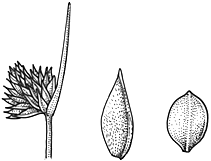Common name: Slender Club-sedge
Isolepis congrua Nees APNI* Synonyms: Scirpus congruus (Nees) S.T.Blake APNI*
Scirpus kochii Maiden & Betche APNI*

Description: Small tufted annual.
Culms filiform, to 20 cm high.
Leaves with blade to 9 cm long. Spikelets 1–5 per inflorescence, 3–5 mm long; involucral bract erect to spreading, exceeding inflorescence, to 15 mm long. Glumes acute, with straight or excurved mucro, sides nerveless or 1-nerved at edge of midrib, (1.3-)1.5–2.0 mm long, hyaline, often tinged yellow to red-brown. Stamen 1. Style 3-fid.
Nut equally triquetrous, broad-ellipsoid to broad-obovoid, third to half as long as glume, 0.4–0.7 mm long, c. 0.4 mm diam., minutely punctulate (often whitish), glistening, dark red-brown to dark grey.
Flowering: spring.
Distribution and occurrence: Grows in seasonally damp situations, west from Mendooran and Ardlethan.
NSW subdivisions: NWS, CWS, SWS, NWP, SWP, NFWP
Other Australian states: Vic. W.A. S.A. N.T.
Close to I. australiensis and I. victoriensis, differing in the broader hyaline sides of the glumes (0.4–0.6 mm wide), which have larger cell outlines. The glumes are usually longer, and the nut is broad-ellipsoid to broad-obovoid, with faces slightly concave and angles acute, prominent.
Text by K. L. Wilson
Taxon concept: Flora of NSW 4 (1993)
APNI* Provides a link to the Australian Plant Name Index (hosted by the Australian National Botanic Gardens) for comprehensive bibliographic data
***The AVH map option provides a detailed interactive Australia wide distribution map drawn from collections held by all major Australian herbaria participating in the Australian Virtual Herbarium project.
|


